

Contents
- Introduction to Under Armour
- Under Armour company profile
- History of Under Armour
- Under Armour mission and vision statement
- Under Armour industry analysis
- Under Armour core values
- Under Armour external analysis
- Under Armour internal analysis
- Under Armour marketing analysis
- Recommendations for Under Armour
- Conclusion
- References
An exhaustive study on the strategic performance of Under Armour
Isabelle Taylor | 16 Sep,2021
Introduction
This article seeks to analyze the growth of the sports apparel and equipment industry and to determine the business strategies and positioning of Under Armour. After reading this article, you will get to know about the overall strategic and competitive positioning of Under Armour as various external and internal analysis tools are used to analyze the factors that are impacting the operations of Under Armour and to evaluate the internal strategies of Under Armour.
Under Armour company profile
Under Armour is an American sports apparel and equipment company that is known for manufacturing and selling various sports equipment such as footwear, casual apparel, and sports items. The headquarter of the company is located in Baltimore, Maryland.
History of Under Armour
Under Armour was founded by Kevin Plank on September 25, 1996, when prototype #0037- The Shorty was developed (Under Armour, 2021). The company earned the sale of $ 17,000 at the end of 1996 and the major competing firms of the company were Nike, Reebok, and Adidas. As a result of this, Under Armour came up with various new apparel lines such as AllseasonGear, StreetGear, TurfGear, and ColdGear. Further, in 1997, the company received orders worth $ 1,00,000. Thus, the company also set up its factory in Ohio to manufacture a large number of shirts. However, the operations of Under Armour were halted in 1999 when the Warner brothers contacted the company to manufacture the outfit for two films. Then, in 2003, Rosewood capital invested $ 12 million into Under Armour, and in the same year, Under Armour launched the first television commercial. Moving further, in 2007, the first full-line retail outlet of Under Armour was established at Westfield Annapolis Mall in Maryland. The company also formed a strategic alliance with baseball Hall under which Under Armour established a significant presence at different venues. Despite this expansion, Under Armour also provided the suits to be worn manufactured by speed skaters in the 2014 Winter Olympics. In February 2015, Under Armour purchased acquired the digital app maker i.e. MyFitnessPal and Endomondo after acquiring MapMyFitness in November 2013. Along with this, in 2016, the company announced a partnership with IBM to improve its computing technology. Furthermore, the company also has partnered with various other firms such as PGA Golfer Jordan Spieth with the aim to launch golf shoes and attract a large number of customers. However, due to the impacts of COVID-19 in 2020, the company had to close its number of stores which resulted in a decline in the revenue of the company by 41 %.
Under Armour mission and vision statement
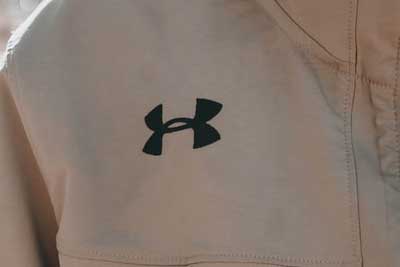
The mission of Under Armour is “to make all the athletes perform better through passion, design, and innovation in the products”. The vision of Under Armour is “to inspire higher performance solutions, the athletes never knew or can’t imagine living without” (Comparably, 2021).
Under Armour industry analysis
The sports apparel and equipment market is growing at the fastest pace as more and more individuals are increasingly participating in sports and recreational activities due to increasing health awareness. The sports apparel market is growing at the CAGR rate of 5.2 % and the global apparel industry is expected to reach the revenue of USD 277,010.78 by the end of 2028. The revenue of the sports goods and apparel market is rising as a result of the increasing demand for apparel goods. The global sports apparel market is highly competitive owing to the increasing growth of the established market players in the retail and e-commerce market. The sales of sporting goods in 2021 amounted to USD 45 billion in the US alone and the market share of US sports amounted to 32.5 % in the global sports market. The revenue of the US sports equipment market in 2020 was USD 14.5 billion (Tighe, 2021). Further, the sports equipment industry is expected to double by the end of 2031 from the US $ 84 billion in 2021. However, it was only in 2020 that the sporting goods industry contracted due to the impacts of COVID-19. Further, the Chinese market was still the exception and continued to grow despite the lockdown conditions. Along with this, the Chinese sports goods market grew at the CAGR rate of 16.5 % between 2015 to 2019 (Becker et al., 2021). The global sports equipment and apparel market has the highest growth rate in the US market which is shown as follows-
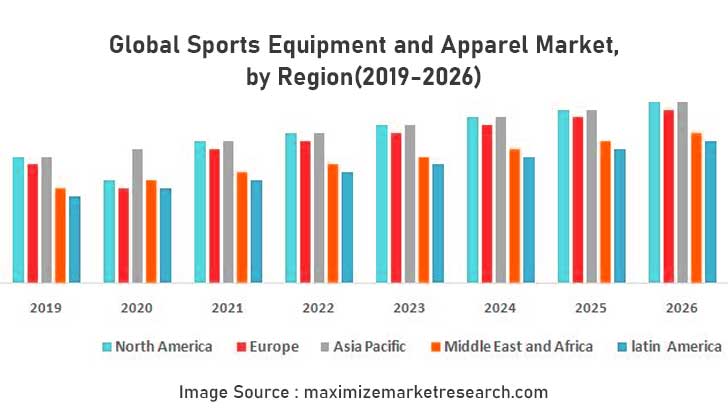
The above figure shows that the sports equipment and apparel market is growing speedily due to increasing health awareness among the customers. Also, it is found that the sports equipment and apparel market also has grown significantly in the Asian Pacific countries. The Asia pacific sports equipment market also earned a total revenue of $ 60.06 billion in 2020 (Marketresearch, 2021). The main reason for the rise in the revenue of sports apparel in the Asia Pacific region is increasing disposable income and improving the lifestyle of people in emerging countries such as India and China (Kbv, 2021).
Under Armour core values
The core values of Under Armour include celebrating the wins, equality, strong thinking, creating fearless connections, making athletes legendary, innovation, etc. The company believes in making the athletes legendary by offering innovative and high-quality sports goods to the athletes. Courage, risk-taking, and conviction are other important core values of Under Armour where the key focus of the company is to launch new and innovative products by taking bold and smart risks.
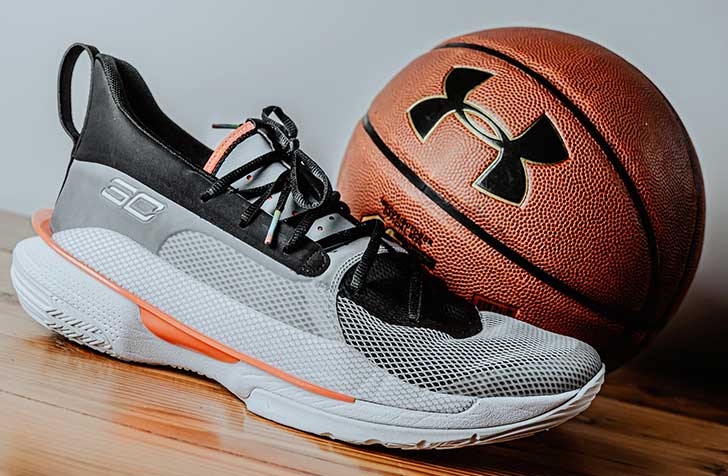
Under Armour external analysis
External analysis refers to the process of analysis of the external environment of the organization. Further, the external analysis of Under Armour is performed in this section of the article to evaluate the factors that are impacting the operations of Under Armour.
PESTEL analysis
The number of external market factors impacts the operations of the organizations which can be evaluated through PESTEL analysis. PESTEL analysis is an important strategic analysis Framework that helps to assess the political, economic, social, technological, environment, and legal environment of the organization. The PESTEL analysis of Under Armour is undertaken as follows-
Political factors affecting Under Armour
The major political factor that is affecting the growth of the sports good companies is changing trade policies and political unrest. The escalating trade war between China and the United State also have negatively impacted the growth of the Sporting goods industry as rising in the tariff rates i.e. 15% duty on the billions of dollars of Sports Equipment such as baseballs, football, lacrosse sticks, etc. have negatively impacted the trade of various sporting equipment and apparel from US (Bray & Moon, 2019). Along with this, restrictive trade policies during the COVID-19 also negatively impacted the overall trade of various goods and services. However, due to the negative impacts of COVID-19, the US government excluded various Chinese products such as textile and apparel from higher tariff rates to facilitate the trade of goods. Also, the Chinese government has declined tariff rates on the import of some textile goods and cotton fiber to ensure reduced import cost of the goods (Shutterstock, 2021). Besides this, the US has bilateral trade relations with India but the Make in India campaign and restrictive trade policies of India has challenged the great trade relationship of the US (Lakshman, 2021). This further negatively affects the overall sales revenue from the export of sports goods companies.
Economic factors affecting Under Armour
As we know that the growth of the sports goods market depends on the economic conditions, GDP, labor market conditions, etc. The GDP rate of the US is 6.6 % in the second quarter of 2021, slightly higher than 6.5 % in the first quarter of 2021. The rise in the GDP rate is the result of the recovery from the impacts of COVID-19 which is further expected to have a positive influence on the growth of the sports goods market. Further, the revenue from the Sports Equipment segment in the US amounted to the US $ 14,744 in 2021. The revenue of the sports goods market is highest from China which is US$28,890m in 2021 (Statista, 2021). The availability of cheap labor is one of the key factors for the faster growth of sports equipment in the market. Further, the unemployment rate in China is only 5 % as compared to the unemployment rate of 6.7 % in the US which leads to higher production of sports equipment and apparel goods (Statista, 2021).
Along with this, the outbreak of COVID-19 also negatively impacted the value of the dollar and the value of the dollar has fallen by 10 to 12% since 2018 (Roach, 2021). The fall in the value of the Dollar is leading to the price competitiveness of the exported goods and cheaper exports help to facilitate an increase in the demand for various Sporting goods. However, the fall in the value of the Dollar also decreases the purchasing power of various Organisations in the international market as it leads to an increase in the price of the imported goods.
Social factors affecting Under Armour
We all know that individuals in the current times are becoming more health-conscious and thus, are participating in various sports and Recreation activities to keep themselves healthy. It is one of the good opportunities for the Sporting goods companies to expand their market share by launching various other Sporting goods and equipment. This further opens new opportunities for the Sporting goods companies to enter the new market by launching various new products and services such as healthy drinks, sports technology, wearable equipment, etc. in the market. Not just this, the desire of the customers to buy branded products also open various opportunities for Global companies such as under Armour to expand their market share through innovative products and services.
Technological factors affecting Under Armour
Technological advancement has gained importance in every sphere of life and new technologies are also boosting up the growth of the sports equipment industry. Sensor technology is one of the most effective technologies that is used in sporting goods in the current times. Also, wearable equipment, tennis sensor tools, etc. have gained huge popularity in the market (Sports, 2021).
Along with this, Sporting goods companies are also investing in 3D printing technology to manufacture innovative athletic shoes. Along with this, Under Armour is also investing in various advanced technologies such as 3D printing to further enhance performance. Under Armour also has recently come up with the 3D printing performance trainer i.e. UA Architech which helps athletes to engage in intense workouts through 360-degree performance training shoes (Walker, 2020).
Environmental factors affecting Under Armour
The customers in current times are becoming more sustainability-conscious. Thus, customers not only demand high quality and innovative sporting equipment but also environmentally friendly Sporting equipment. The rising issue of Climate Change also has necessitated the organizations to launch environment-friendly and sustainable Sporting equipment. Various Sporting equipment and apparel companies such as Adidas, Nike, Asics, etc. are implementing various environmental sustainability practices to address environmental issues (Sportanddev, 2021). Under Armour is also a member of the Sustainable apparel coalition that helps the company to lead the apparel footwear and textile industry by ensuring no harm to the environment. However, activists from the rainforest action network also accused Under Armour of destroying forests, contributing to human rights abuses as well as climate pollution (Matthews, 2017).
Legal factors affecting Under Armour
Various laws and regulations such as the flammable fabrics act, a general certificate of conformity, American Society for testing and materials standards, CPSIA standards, etc. regulate the manufacturing, import, and sale of various Sporting apparel and equipment in the industry (Mo, 2020). However, the offices of Under Armour are located in London, Jakarta, Hong Kong, New York City, Panama City, Mexico City, Guangzhou, Houston, Toronto, etc. which requires the company to comply with various rules and regulations of these countries. Along with this, Under Armour is alleged for improper accounting and breach of the federal securities laws which required the company to pay $ 9 million for settling the federal regulatory charges (MIRABELLA, 2021).
Under Armour Porter's 5 forces analysis
Porter 5 forces analysis is an important external market analysis tool that helps to evaluate the competitive forces shaping the sports equipment industry. The Porter 5 forces analysis of Under Armour is carried out as follows-
| Porter 5 forces analysis | Level of threat | |
|---|---|---|
| Bargaining power of buyers of Under Armour | High | The bargaining power of buyers in the sports equipment and apparel market is high as customers have a long list of options when it comes to buying sports apparel and other goods. The variety of options available to the customers not only include variety in terms of the sports equipment but also include variety in terms of the quality and price of the goods which further raises the bargaining power of the buyers in the industry. Along with this, the established brand image and recognition of Under Armour also increases the intention of the buyers to pay a premium price for their products. |
| Bargaining power of suppliers for Under Armour | Moderate | The bargaining power of suppliers in the sports equipment and apparel industry is moderate as sport equipment companies such as Under Armour buy raw material in large quantities from the suppliers which reduce the bargaining power of suppliers in the industry. However, the degree of innovativeness involved in sport apparel materials increases the bargaining power of suppliers. Under Armour also buys 39 % of its fabrics and other material from only 5 suppliers which further has raised the bargaining power of suppliers. |
| Threat of new entrants to Under Armour | Low | There are a number of barriers that restrict the entry of new firms into the sports apparel industry. The amount of capital investment, manufacturing cost, economies of scale, distribution cost, the effectiveness of distribution channels, strong brand image of Under Armour, etc. reduces the threat of new entrants in the industry. However, the new firms can still enter the industry by marketing an innovative product relating to one particular sport such as Golf or tennis. This further requires huge capital investment. Thus, the threat of entry of new firms is low in the sports equipment industry. |
| Threat of substitutes to Under Armour | High | When it comes to substituting products in the Sports Equipment and apparel industry, the level of threat of substitutes is very high for Under Armour as there are various competitive firms in the industry that supply sports apparel as well as equipment. Furthermore, the presence of firms selling performance apparel, sports goods, sports footwear, and accessories is rising in the current times which further increases the risk of threat of substitute products in the industry. |
| Threat of competitive rivalry to Under Armour | High | The rivalry among the existing firms in the industry is also very high in the sports apparel and equipment industry due to the presence of a large number of competitors. The main competitors of Under Armour include Nike, Adidas, Columbia sportswear, Fila, Umbro, Ralph Lauren, etc. The presence of these competitors and the innovative products being launched by these firms increase the threat of competition in the industry. However, to deal with these challenges, Under Armour has implemented various innovative practices to improve its brand equity and loyalty in the market. |
Under Armour competitor’s analysis
Despite the strong market share and higher loyalty among the customers, Under Armour is still facing fierce competition from various firms in the footwear, apparel, and accessories industry. The main competitors of Under Armour include Nike, Asics, Skechers, Reebok, Fila, New Balance, Puma, etc. Nike has established a strong market share in the sports footwear as well as apparel industry with a strong brand image and endorsement strategies. The list of endorsements of the company such as Michael Jordan, James Roger, Kobe Bryant, Maria Sharapova, etc. further forces the other sports and apparel companies such as Under Armour to spend huge sums of money in the marketing strategies to increase their brand presence and competitive position in the industry. Along with this, the Global reach of Nike further creates a strong competitive threat for Under Armour. In addition to this, Adidas is another dominating footwear and apparel brand in the sports industry which further increases the competitive threat for Under Armour. Adidas also performs effectively in the North American market which is one of the main reasons for decreasing market share of Under Armour in the industry. Along with this, puma is also another important competitor of Under Armour as the variety of goods offered by puma further increases the competitive threat for Under Armour. The other main competitor of the company is New Balance which differentiates its products by adding technical features in its products such as blended gel insertion. The other main competitors of Under Armour are Asics and Sketchers which are known for manufacturing and selling sports footwear, apparel and sports equipment. The performance and lifestyle division of Sketchers further attracts a number of athletic and casual shoes. Also, Fila has established both online and offline specialty stores to offer convenience to customers (Farooq, 2019). The competitor analysis of Under Armour is shown as follows-
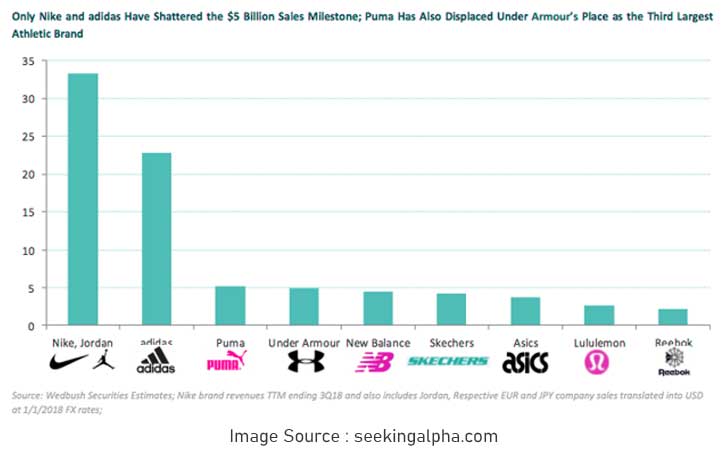
Under Armour competitor’s strategy analysis
The key competitive strategy adopted by Under Armour includes superior product innovation and unique marketing initiatives. The product differentiation strategy helps the company to establish a strong brand image in the market. Furthermore, Under Armour does not come up with the alternatives to the existing products but comes up with innovative products different from the competitor products to establish a strong brand image in the market (Mentor, 2018). The product differentiation of Under Armour helps to increase the overall market share of the company which is shown as follows-
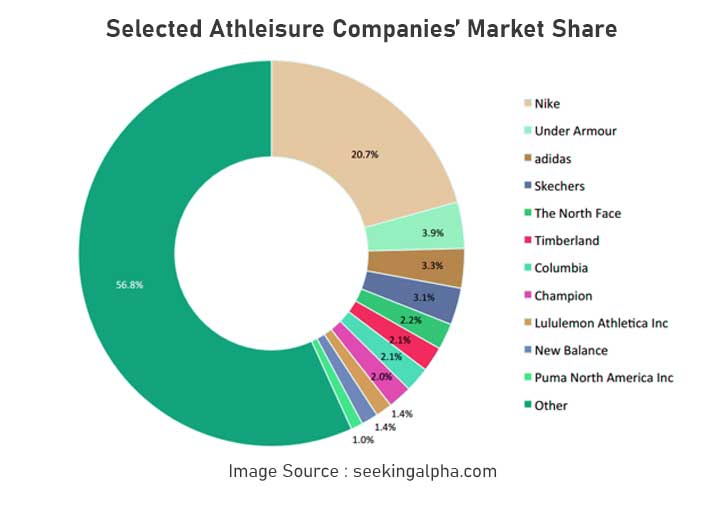
Under Armour positioning analysis
Under Armour is recognized as one of the most innovative and high-performance brands as Under Armour specializes in high-quality clothing items tailored to effectively meet the needs of athletes. Along with this, the continued focus of the company on innovative technology has helped Under Armour to further establish a strong competitive position in the industry.
Under Armour internal analysis
The internal analysis involves an analysis of the internal environment of the company. In this section, the internal analysis of Under Armour is carried out as follows-
Under Armour VRIO analysis
VRIO analysis is an analytical framework that can be used to evaluate the internal resources of the company. The VRIO analysis of Under Armour is executed as follows-
| Resources and capabilities | Valuable | Rare | Inimitable | Organized | Competitive advantage |
|---|---|---|---|---|---|
| Financial resources | Yes | Yes | No | No | Temporary competitive advantage |
| Product portfolio | Yes | Yes | Yes | Yes | Long term competitive advantage |
| Marketing and promotion | Yes | Yes | Yes | No | Competitive parity |
| Sales and distribution channel | Yes | Yes | Yes | Yes | Long term competitive advantage |
| Digital fitness subscriptions | Yes | Yes | No | No | Temporary competitive advantage |
| Quality assurance | Yes | Yes | Yes | Yes | Long term competitive advantage |
| Ethical practice | Yes | No | No | No | Competitive parity |
| Inventory management | Yes | Yes | Yes | Yes | Long term competitive advantage |
| Brand image | Yes | Yes | No | No | Temporary competitive advantage |
| Pricing strategies | Yes | No | No | No | Competitive parity |
| Intellectual property | Yes | Yes | Yes | Yes | Long term competitive advantage |
| Human capital management | Yes | Yes | Yes | Yes | Long term competitive advantage |
Under Armour Non-Core Competencies and Competitive Disadvantage
The key areas of the non-core competencies of Under Armour include ineffective Financial resources, limited marketing strategies, limited digital fitness subscription, unethical conducts, shrinking brand presence, and ineffective pricing strategies.
Despite rising concern for sustainability, the company is still engaged in various unethical conducts such as breach of federal security laws, killing of animals, etc. Such unethical conduct are tarnishing the brand image of Under Armour and are negatively impacting the trust of customers in the brand. Along with this, the marketing strategies is an area of non-core competency of Under Armour as various other brands such as Nike also have engaged in various celebrity endorsements and other marketing strategies. Despite the engagement in various marketing activities, the marketing strategies of Under Armour are still ineffective which also is leading to competitive parity for the organization. Along with this, the brand image of Under Armour is also minimal when compared to the brand image of Nike and Adidas. The company focuses on the value-based pricing strategy but the premium branding strategy of Nike has further impacted the brand value of Under Armour. The athletes prefer to buy Nike products as a status symbol and with the belief that Nike offers high quality products to customers. Thus, Under Armour faces huge competition in the industry and the business strategies of competitor firms have a significant impact on the competitive position of Under Armour. Along with this, the overall financial and operational performance of Under Armour is very poor and the outbreak of COVID-19 resulted in Net loss of (549,177,000).
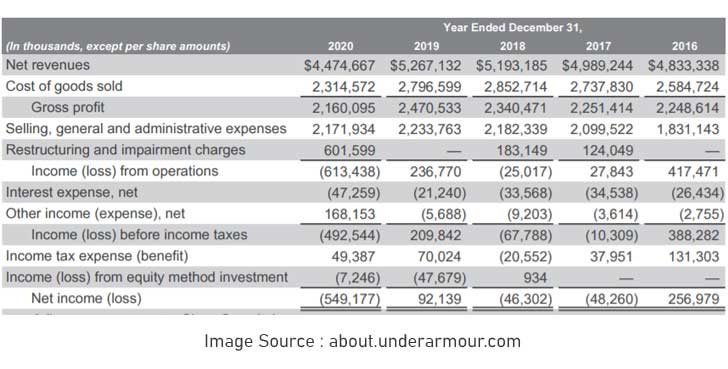
Under Armour core competencies
The core competency of Under Armour is a strong product portfolio and in the fiscal year 2020, the sales of the apparel goods represented 64 % as compared to 21 % of footwear and 9% of accessories. Furthermore, the connected fitness business also generated revenue of 6% in 2020.

The core competency of Under Armour also includes the licensing agreement of Under Armour with various third parties to manufacture apparel, footwear and sports equipment. The company also has effective sales and distribution channels as Under Armour sell the products to customers through wholesale channels, direct to customer’s channels, licensing and connected fitness channel.
The human resource management strategies of Under Armour are effective enough to provide a strong competitive advantage to Under Armour. The company focuses on creating an inclusive culture for its employees and as of 31 December, 2020, under Armour had a total of 16600 team mates worldwide with 51 % white, 21 % Hispanic, 17 % black and 6 % Asian. Along with this, effective reward strategies of Under Armour are also aimed at providing market competitive rewards to employees to further ensure higher employee satisfaction, retention and effective production outcomes.
The intellectual property provides strong competitive advantage to Under Armour as the company owns various trademarks for UA Logo, Under Armour, armour fleece, armour bra, heat gear, cold gear, etc. The trademarks help Under Armour to maintain product differentiation and a strong brand image.
Under Armour core resources and capabilities
Under Armour sources products from a limited number of suppliers with the aim to maintain a high quality of production and innovativeness. Many of the fabrics and the raw material used in the manufacturing of the sports apparel and accessories are technically advanced and are procured from Limited number of suppliers. Also 39% of the fabric used in the manufacturing of the sports apparel and other equipment are procured from only 5 suppliers. However, the manufacturing processes of the company are executed at different levels and in fiscal 2020, apparel goods of Under Armour were manufactured by 50 primary contractors in 18 different countries. Along with this, the other Core capability of Under Armour is higher Quality Assurance of its goods as the company has established the code of conduct for Quality Assurance in all products. Under Armour manages its inventory on the basis of the existing stock, customer requirements, and the anticipated sales. The main focus of the inventory management practices of the company is to ensure higher customer satisfaction by effectively meeting the needs of the customers.
Under Armour SWOT analysis
SWOT analysis is an important strategic evaluation framework that helps to evaluate the strengths, weaknesses, market opportunities and threats to the organization. The SWOT analysis of Under Armour is shown as follows-
| Strengths | Weaknesses |
|---|---|
|
|
| Opportunities | Threats |
|
|
The SWOT analysis of Under Armour depicts that Under Armour is one of the leading sports apparel companies that has established a strong brand image in the market due to its strong product portfolio, effective and multiple distribution channels, digital apps and quality assurance processes. However, it is found that the company majorly focuses on the value based strategies which results in lack of satisfaction of the customers who want the discounted pricing strategies from time to time. The main opportunity available to Under Armour is to enter the new markets and expand its product line beyond the sports goods to further raise its market share. Despite this, the company is still facing various market threats such as higher import and export tariffs due to the US China war, higher threat of substitute goods, and competitive pressure which can negatively impact the competitive position of the company.
Under Armour business strategy analysis
The major strategies adopted by Under Armour include superior product innovation, differentiation and unique marketing strategies. The main focus of the company is to raise its brand image. Thus, the company spends a greater proportion of its marketing budget on increasing brand awareness. Along with this, Under Armour has adopted the blue ocean strategy in the market which includes the pursuit of differentiation and low-cost strategies to establish a strong competitive position in the market. The discounting strategies of Under Armour is minimal as the customers are also willing to pay the full price for the goods due to their style, performance, and the fit of the products. Furthermore, the company is also planning to invest in personalized marketing strategies and CRM programs to further improve customer engagement and repetition (Vizard, 2021). Along with this, the company invested around $ 579 million in 2019 in its promotional strategies with higher focus on celebrity endorsement, sporting partnership, online communication, etc.
Despite this, the other main business strategies of Under Armour include direct-to-consumer strategies, e-commerce sales, etc. further, Under Armour is currently cutting off the partnership with 2000 to 3000 partner stores to further strengthen its direct-to-customer strategies. Furthermore, in 2020, the revenue of Under Armour from the wholesale channels declined by 25 % whereas the direct to customer sales increased by 2 % to $ 1.8 billion (Thomas, 2021).
Under Armour business model
Under Armour is shifting its business model from the shirts and shoes company to the pure tech company as the main focus of the company is to make all the athletes better performers through various quality products and digital services. The main focus of the Under Armour is to embrace digital transformation and to create higher value for the connected athlete. The digital innovation strategy of UA is focused on establishing higher customer satisfaction by connecting athlete’s devices and providing actionable insights for healthier performance of the athletes. The company has invested $710 million in the past few years to acquire and develop digital fitness apps. However, the company sold its MyFitnessPal platform in December 2020 which was one of the most important and largest platforms within the connected fitness segment (Muoio, 2020). This further has resulted in a decline in the operating income of Under Armour from the connected fitness which is shown as follows-

Under Armour business canvas model
Business model canvas is an important strategic management technique that helps to analyse the overall building blocks of the organization. The Business model canvas of Under Armour is prepared as follows-
| Key partners | Key activities | Value propositions | Customer relationships | Customer segments |
|---|---|---|---|---|
|
|
|
|
|
| Key resources | Channels | |||
|
| |||
| Cost structure | Revenue streams | |||
|
| |||
Under Armour marketing analysis
Marketing analysis involves the evaluation of the marketing plan and the marketing strategies of the organization. The Marketing analysis of Under Armour is performed in this section to evaluate the marketing strategies of Under Armour.
Under Armour marketing mix
Marketing mix refers to the set of actions or the strategies adopted by the organization to promote its brand and the products in the market. The marketing mix of Under Armour is evaluated as follows-
Under Armour products strategy
Under Armour specializes in manufacturing apparel and sports equipment manufacturing for all age groups. The Product offering of Under Armour consist of footwear, apparel and sport accessories for men, women and youth. The apparel is offered by Under Armour in different fits and styles with the aim to enhance the comfort of the customers. The apparel line of Under Armour can also be divided into different categories on the basis of the fabrics of the goods such as HotGear, All Season Gear, and ColdGear. The apparel line on the basis of high technology include Threadborne, Supervent, Coolswitch, Sunblock, etc. The footwear sold by Under Armour is generally light and built with consideration of the performance attributes. The accessories line includes the sale of gloves, bags, sports masks, headwear, etc. besides this, Under Armour also offers digital fitness subscriptions through MapMyFitness platform which include applications, such as MapMyRun and MapMyRide.
Under Armour pricing strategy
Under Armour has adopted the value based pricing strategy for its apparel, footwear and other products. Furthermore, the major customers of Under Armour include the players and athletes who focus on the functionality and performance of the products. Under Armour charges a little extra price for its products through the use of super innovative materials and fabrics.
Under Armour placement strategies
Under Armour sells its products to the customers through various distribution channels which include the wholesale channels, independent retailers, department stores, online website i.e. www.underarmour.com, licensing, connected fitness channels etc. The highest revenue of Under Armour comes from the North American segment where the company sells its apparel, footwear and other products through wholesale and direct distribution channels. Furthermore, the company has 176 factory house stores and 18 brand house stores in North America. Along with this, the company sells its products in China, India, Australia and South Korea through the stores operated by the distribution and wholesale partners as well as through the online website. Not just this, the company also licenses with various third parties which further helps to increase its market reach. The licensing agreement of Under Armour with Dome Corporation helps to sell its products in Japan.
Under Armour promotional strategies
Under Armour has adopted Integrated marketing strategies, be it personal selling, sponsorships, television and magazine ads, sports events, celebrity endorsement, camps and clinics for young people, etc. (FELONI, 2015). The company also sells its products to the international sports teams which also helps to drive brand awareness in different countries around the world. The social media marketing strategy of Under Armour also helps to promote engagement and connectivity of the customers with the brand. The company also promotes its products in the market through its retail marketing strategy which aims to increase the brand floor space and ensure higher brand awareness through point of sale displays and concept shops. The new brand campaign of Under Armour “The Only Way is Through'' was also introduced with over 180 social media influencers to motivate the athletes to put in hard work and get better performance. Under Armour also has developed strong public relations through its social campaigns like “Basketball matters, community matters more” under which the company has developed a number of basketball courts for the kids to play.
Under Armour Social media marketing analysis
Under Armour has established extensive social media presence through extensive use of various social media sites. The pleasing and interactive website of Under Armour allows the company to market and advertise its products to customers. The company has created a number of Facebook accounts besides its central Facebook page to target specifically women, football fans, basketball fans, etc. The Twitter accounts of the company are also numerous and the specific profiles include “Under Armour Basketball'', “Ask Team UA,”, etc. (Leers, 2021). The extensive Pinterest profile of Under Armour helps to target women where the company regularly publishes different posts featuring its products, workouts, product functions, etc. Not just this, Under Armour also has its presence on Instagram where the company regularly posts photos of the sponsored Athletes. Along with this, the company also has begun incorporating user-generated content such as customer reviews, customer videos, etc. into its product listing to further communicate its performance to the customers and ensure higher brand image (Thau, 2021). The social media traffic of Under Armour is exhibited as follows-

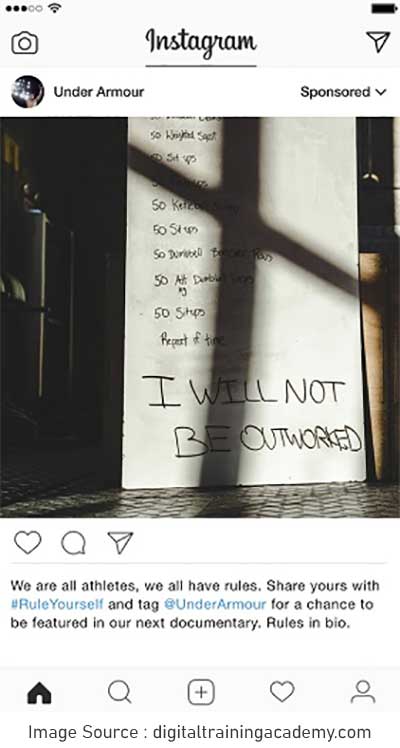
In addition to this, the company also has started #RuleYourself campaign on Facebook and Instagram to deliver great content and improve its brand image.
Under Armour aimed to reach its target audience of 13-14 millennials through its inspiring content. Further, Under Armour also posted various photos and videos with Michael Phelps and Stephen Curry on its Facebook and Instagram page to further improve customer motivation to share the rules that keep them motivated. As a result of this campaign, there was an increase in purchase intention of customers by 5 points, an increase in message association by 4 points, and an increase in ad recall by 7 points (Digitaltraining, 2021).
Under Armour STP analysis
The STP Model consists of three steps that help to evaluate the target audience of the company and the way the company communicates its products and services to the specific customer segments. The STP analysis of Under Armour is presented as follows-
Under Armour Segmentation
The customers of Under Armour can be categorized on the basis of demographic, geographic, behavioral, and psychographic segments which is illustrated as follows-
| Segmentation | Segmentation criteria | Under Armour customer segments |
|---|---|---|
| Geographic | Region | Global |
| Density | Urban | |
| Demographic | Age | Above 16 years |
| Gender | Male and female | |
| Life cycle | Young bachelor, newly married and married with children | |
| Occupation | Professionally driven athletes, students, employed | |
| Behavioral | Loyalty | Hardcore loyals, switchers, softcore loyals |
| Personality | Active and healthy lifestyle, determined | |
| Benefits sought | Functionality and cost effective | |
| Psychographic | Social class | Middle to upper class |
| Lifestyle | Struggler, aspirer, explorer |
Under Armour Target market
The target market of Under Armour mainly includes athletes or the young individuals having strong interest in sports activities. The company mainly targets customers above the age of 16 years and the main target audience of the company is in the US but the company also sells its products at the international level. Furthermore, the company also targets women customers and children for its apparel, footwear and sports accessories.
Under Armour positioning map
Under Armour is recognized as one of the most innovative and technologically advanced companies that sells a variety of products to customers. The company also makes athletes feel better and perform greater as the company uses innovative material and fabrics which improve the overall functioning of its products. Thus, Under Armour is positioned as the brand, whose every product does something great for the customers. The positioning map of Under Armour is shown as follows-
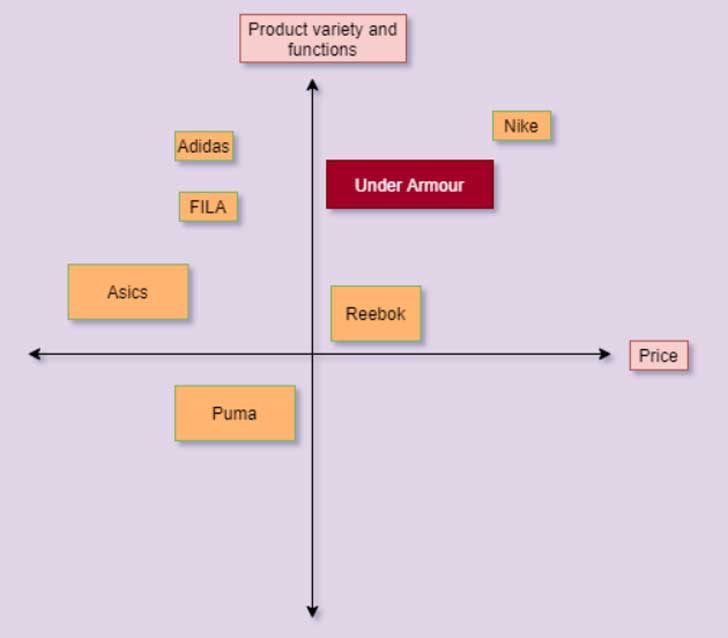
Under Armour is known for the high functioning of its products. The value-based pricing strategy of Under Armour also helps to motivate the customers to pay a premium prices for the style and functioning.
Recommendations for Under Armour
Although Under Armour has developed effective marketing strategies, the external and internal analysis of Under Armour reveals that Under Armour continues to face huge competitive threats due to the increasing presence of competitors. Furthermore, it is found that there is a higher threat of substitutes for Under Armour due to the presence of a number of competitors and lack of product differentiation. Thus, the following are some of the recommendations provided for Under Armour-
- Under Armour should increase its focus on the international market by establishing an effective distribution channel in Europe. The main opportunity available to Under Armour is to acquire the established firms to further improve its competitive position in the international market.
- Under Armour should also adopt the intelligent assistance customer service to further provide 24/7 facilities to the customers and to provide proactive service delivery to the customers. The use of the AI can also help to effectively respond to customer complaints and queries.
- Under Armour should also increase its market share in the women sports segment to further increase its market share. Women's sports goods are rising in the current times. Thus, the focus on women's apparel and footwear items should be increased to improve its customer base.
- Under Armour should also improve its social media presence through use of the homeland embassy approach as through this approach, the customers will be able to view every aspect of the social media presence of Under Armour on its webpage. Moreover, the use of this strategy will also help to improve its brand awareness by ensuring that the customers can view the photos and statues from Facebook, Instagram, or other social media pages on corners of its page.
- Under Armour should also expand its product line by adopting the product development strategy under the Ansoff matrix to further improve its brand image in the market.
Conclusion
The strategic analysis of Under Armour reveals that Under Armour is one of the leading sports goods companies that has achieved a significant position in the market for its effective marketing and business strategies. It is seen that the company mainly focuses on product differentiation and innovation strategies which helps the company to effectively deal with the competition in the market. However, the threat of substitutes and competitive rivalry in the industry is still very high. Thus, it is recommended that Under Armour needs to improve its market share by expanding its product portfolio and focusing on the women's sports market.
References
- Becker, S., Berg, A., Thiel, A., & Kohl, S. (2021). Eight trends are shaping the sporting goods industry in 2021. To win in the next normal, players must adapt to a shifting landscape.. mckinsey. Retrieved 9 September 2021, from https://www.mckinsey.com/industries/retail/our-insights/sporting-goods-2021-the-next-normal-for-an-industry-in-flux.
- Bray, C., & Moon, L. (2019). Tariffs could throw US sporting goods firms for loss. South China Morning Post. Retrieved 9 September 2021, from https://www.scmp.com/business/companies/article/3025115/tariffs-could-leave-us-sporting-goods-firms-ropes-trade-war.
- Comparably. (2021). Under Armour Mission, Vision & Values. Comparably. Retrieved 9 September 2021, from https://www.comparably.com/companies/under-armour/mission.
- Digitaltraining. (2021). Digital marketing case study - Under Armour encourages consumers to #RuleYourself on Facebook and Instagram - Digital Training Academy. Digitaltrainingacademy.com. Retrieved 15 September 2021, from http://www.digitaltrainingacademy.com/casestudies/2017/04/under_armour_encourages_consumers_to_ruleyourself_on_facebook_and_instagram.php.
- Farooq, U. (2019). Under Armour Competitors - Competitors Analysis of Under Armour Inc.. Marketing Tutor. Retrieved 9 September 2021, from https://www.marketingtutor.net/under-armour-competitors/.
- FELONI, R. (2015). The athlete endorsements that are turning Under Armour into Nike's strongest competitor. Business Insider. Retrieved 15 September 2021, from https://www.businessinsider.in/retail/the-athlete-endorsements-that-are-turning-under-armour-into-nikes-strongest-competitor/articleshow/47694276.cms.
- Kbv. (2021). Sports Apparel Market Size, Share & Growth Report by 2022. KBV Research. Retrieved 9 September 2021, from https://www.kbvresearch.com/global-sports-apparel-market/.
- Lakshman, S. (2021). U.S. trade report flags challenges from ‘Make in India’ policy. The Hindu. Retrieved 9 September 2021, from https://www.thehindu.com/business/Industry/us-trade-report-flags-challenges-from-make-in-india-policy/article33966691.ece.
- Leers, A. (2021). SOCIAL MEDIA STRATEGIC PLAN FOR UNDER ARMOUR. Digitalcommons.liberty.edu. Retrieved 15 September 2021, from https://digitalcommons.liberty.edu/cgi/viewcontent.cgi?article=1467&context=honors
- Marketresearch. (2021). Sports Equipment Retail in Asia-Pacific - Market Summary, Competitive Analysis and Forecast to 2025. Marketresearch.com. Retrieved 9 September 2021, from https://www.marketresearch.com/MarketLine-v3883/Sports-Equipment-Retail-Asia-Pacific-14590502/.
- Matthews, R. (2017). Are Under Armour’s Sustainability Claims Green or Greenwashing?. The Green Market Oracle. Retrieved 9 September 2021, from https://thegreenmarketoracle.com/2017/11/29/are-under-armours-sustainability/.
- Mentor. (2018). Under Armour Case: Generic Competitive Strategy - Academic Mentor Online. Academic Mentor Online. Retrieved 9 September 2021, from http://www.academicmentoronline.com/2018/08/under-armour-case-generic-competitive-strategy/.
- MIRABELLA, L. (2021). Under Armour agrees to pay $9 million to settle an SEC probe into accounting practices. baltimoresun. Retrieved 9 September 2021, from https://www.baltimoresun.com/business/bs-bz-under-armour-accounting-settlement-20210503-wzqklvorlvf2zjbgjjwvhwezpa-story.html.
- Mo, C. (2020). Sportswear Product Regulations in the United States: An Overview. Compliance Gate. Retrieved 9 September 2021, from https://www.compliancegate.com/sportswear-regulations-united-states/.
- Muoio, D. (2020). Under Armour sells off MyFitnessPal for $345M, and will shut down Endomondo by 2021. MobiHealthNews. Retrieved 15 September 2021, from https://www.mobihealthnews.com/news/under-armour-sells-myfitnesspal-345m-will-shut-down-endomondo-2021.
- Roach, S. (2021). Brace yourself: The US dollar’s big crash has only just started. mint. Retrieved 9 September 2021, from https://www.livemint.com/opinion/columns/brace-yourself-the-us-dollar-s-big-crash-has-only-just-started-11611675404882.html.
- Shutterstock. (2021). The US-China trade war continues to impact the textile industry. Fibre2fashion.com. Retrieved 9 September 2021, from https://www.fibre2fashion.com/news/textile-news/us-china-trade-war-continues-to-impact-textile-industry-272330-newsdetails.htm.
- Sportanddev. (2021). Protecting our planet: Sports brands | sportanddev.org. Sportanddev.org. Retrieved 9 September 2021, from https://www.sportanddev.org/en/article/news/protecting-our-planet-sports-brands.
- Sports. (2021). Five Exciting New Technologies Being Used in the Sports Industry - Sports Management Degree Guide. Sports Management Degree Guide. Retrieved 9 September 2021, from https://www.sports-management-degrees.com/lists/five-exciting-new-technologies-being-used-in-the-sports-industry/.
- Statista. (2021). Monthly unemployment rate in the United States from August 2020 to August 2021(seasonally-adjusted). Statista. Retrieved 9 September 2021, from https://www.statista.com/statistics/273909/seasonally-adjusted-monthly-unemployment-rate-in-the-us/.
- Statista. (2021). Sports Equipment - United States | Statista Market Forecast. Statista. Retrieved 9 September 2021, from https://www.statista.com/outlook/cmo/toys-hobby/sports-equipment/united-states.
- Thau, B. (2021). Under Armour Uses User-Generated Content in E-Commerce Strategy. https://www.uschamber.com/co. Retrieved 15 September 2021, from https://www.uschamber.com/co/good-company/the-leap/user-generated-content-ecommerce-by-under-armour.
- Thomas, L. (2021). Under Armour pursues plans to break ties with some retailers in push for more profitable sales. cnbc. Retrieved 15 September 2021, from https://www.cnbc.com/2021/02/10/under-armour-reiterates-plans-to-break-ties-with-some-retailers-shares-rally.html.
- Tighe, D. (2021). Topic: Sporting Goods Industry in the U.S.. Statista. Retrieved 9 September 2021, from https://www.statista.com/topics/961/sporting-goods/.
- Under Armour. (2021). About Under Armour | Under Armour SG. Under Armour. Retrieved 9 September 2021, from https://www.underarmour.com.sg/en-sg/about-under-armour.html.
- Under Armour. (2021). About Under Armour | Under Armour SG. Under Armour. Retrieved 9 September 2021, from https://www.underarmour.com.sg/en-sg/about-under-armour.html.
- Vizard, S. (2021). Under Armour shifts strategy to invest in product and brand. Marketing Week. Retrieved 15 September 2021, from https://www.marketingweek.com/under-armour-marketing-brand-strategy/.
- Walker, N. (2020). Under Armour produces its first 3D-printed performance trainer. manufacturing global. Retrieved 9 September 2021, from https://manufacturingglobal.com/technology/under-armour-produces-its-first-3d-printed-performance-trainer.
